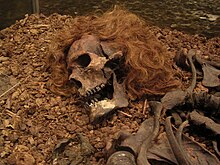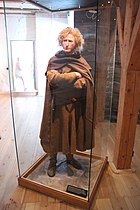Bocksten Man
This article needs additional citations for verification. (April 2012) |
Bocksten Man | |
|---|---|
Bockstensmannen | |
 | |
| Died | |
| Cause of death | Homicide |
| Body discovered | 1934 (shoe sole) 22-23 June 1936 (skeleton) |
| Resting place | Halland Museum of Cultural History, Varberg, Halland County, Sweden |
| Era | fl. c. 1250-1520 |
| Known for | His well-preserved remains |
| Height | 170–180 cm (5 ft 7 in – 5 ft 11 in) |
The Bocksten Man (Swedish: Bockstensmannen) is the remains of a medieval man's body found in a bog in Varberg Municipality, Sweden. It is one of the best-preserved finds in Europe from that era and is exhibited at the Halland Museum of Cultural History (formerly known as Varberg County Museum). The man had been killed and impaled to the bottom of a lake which later became a bog. The bog where the body was found lies in Rolfstorp in Halland County, about 24 kilometres (15 mi) east of Varberg on the west coast of Sweden, close to the most important medieval road in the area: the Via Regia. In 2006, he was reconstructed to show what he may have looked like when he was alive, and it was displayed in the museum alongside the original skeleton.[1][2]
Discovery
[edit]In the 1880s, a farm called "Bocksten" was established near a bog. The bog was then regularly drained, and a harrow was used to gather peat. The farm owner Albert Johansson had previously found a leather shoe in the wetland and gave it to the Varberg County Museum. A shoe sole was found in the bog in the summer of 1934. The body was found by Albert Johansson's son Thure G. Johansson while gathering peat on 22 June 1936. His harrow apparently caught on sackcloth. On examination, Johansson saw parts of a skeleton. The next day, Johansson and his father contacted the local police and a doctor. On investigation, they realized it was too old to be of criminal interest.[citation needed]
Johan Albert Sandklef (1893–1990), director of Varberg County Museum, took charge, inviting others — among them naturalist and geologist Lennart von Post (1884–1951), professor at Stockholm University. The group visited on 24 June. They measured and photographed the find before excavating it. The upper parts of the man had passed through the harrow and were badly damaged while the lower parts were intact.[3][4]
The Swedish Museum of National Antiquities was consulted after the midsummer weekend to assist with conservation. Curator Gillis Olson and textile expert, historian and archaeologist Agnes Teresa Geijer (1898–1989) took part in the conservation and evaluation. They came to Varberg on 9 July, assisting Sandkelf in the documentation and giving conservation advice. The Bocksten Man has been part of the museum's exhibition since 1937.[5]
Description
[edit]The man was 170–180 centimetres (5 ft 7 in – 5 ft 11 in) tall and of slender build. There is an injury covering about 8 by 5 centimetres (3 in × 2 in) on the right side of the cranium. Of the inner organs, parts of the lungs, liver and brain as well as cartilage are preserved. The man had been impaled to the lake bed with two poles; one of oak that hit his heart and one of beech which went through his back.[citation needed]

The tunic is among the best-preserved medieval tunics in Europe and is made of woollen fabric. He was wearing a gugel hood with a 90-centimetre (35 in) long and 2-centimetre (0.79 in) wide liripipe ("tail"). On his upper body, he wore a shirt and a cloak, while his legs were covered by hosiery. Apart from the clothing he had a fabric bag, foot coverings, leather shoes, a belt, a leather sheath and two knives. The leather sheath was 40 millimetres (1.6 in) wide and 62 millimetres (2.4 in) long, composed of three layers with a combined saltire and St George's Cross (thus giving a pattern similar to the Union Jack) carved on the outer layer. On the inner layer, a similar pattern was carved, though this time a pole was added to the symbol.[6][citation needed]
Interpretations
[edit]Several people have evaluated the finding, among them museum director Johan Albert Sandklef, Gunnel Margareta Nockert of Uppsala University and historian Owe Wennerholm. All three have written books regarding their findings.
Date
[edit]The find is generally dated to the 14th century. The dating is based on the clothing, especially the type of hood he wore. Albert Sandklef specified the date of the find as the 1360s, while Margareta Nockert suggests the 1330s. Owe Wennerholm argues that the hood he wore was used over a much larger time frame and only limits the date of the find to between 1250 and 1520. He does however put forward the hypothesis that the man might be Simon Gudmundi, a 15th-century priest, known to have died in 1491.[citation needed]
A piece of the cloth was radiocarbon dated in the late 1980s. It gave as a result a 68 percent likelihood of a date between 1290 and 1410 and a 95 percent likelihood of a date between 1290 and 1430. Some uncertainties do however arise as the conservation process might have affected the result. The fact that the find came from a bog is also of concern, as bog finds are known to be hard to date.[citation needed]
Age
[edit]Based on the teeth, Gunnar Johansson forensic odontologist and department head of the Faculty of Odontology at Karolinska Institute, has concluded that the man was between 25 and 35 years old when he died. Based on the skeleton, osteologist Nils-Gustaf Gevall (1911–1991) of Stockholm University, came up with an age of between 35 and 40 years, though the man might have been up to 60 years old.[7][8]
Social group
[edit]Depending on the interpretation of the clothing, and in particular the hood, different conclusions can be made about the man's social background. The hood he wore was usually worn by the more prosperous classes of medieval society and it has therefore been suggested that he may have been either a tax collector or a soldier recruiter. The type of hood was also used within the Roman Catholic Church. Based on this and a symbol on a shield-shaped pendant, it has been suggested by Owe Wennerholm that the man belonged to the religious order Ordine di Santo Spirito.[citation needed]
Local legend
[edit]Some days after the find was revealed, a local farmer (Karl Andersson) told Albert Sandklef of a legend he had heard as a child. Two old people from Åkulla had told his father about a man who was recruiting soldiers in the area. He had been killed by the peasants and buried in a bog. He would start haunting late at night, and in order to stop this, poles were struck through his body, whereafter the haunting stopped. As far as the farmer could remember they mentioned Store Mosse, a bog about 10 miles (16 km) from the find, close to Nackhälle village, though he acknowledged that his memory might fail him as he had grown up in the vicinity of that bog. The farmer and Albert Sandklef went to Nackhälle and questioned several older people in the area. However, nobody recognized the legend.[citation needed]
Cause of death
[edit]It has been a matter of some discussion about what actually caused the death of the man. In January 2006 a professor and a doctor at Sahlgrenska University Hospital performed an "operation" on a plastic model of the body, based on computed tomography of the body. As a result, they concluded that he had first been hit at the lower jaw, then at the right ear and finally a lethal hit further towards the back of his head.[9]
Identity
[edit]A hypothesis has been presented that the person was Simon Gudmundi, the dean of the Diocese of Linköping who died on 12 May 1491. In his 1998 book, Vem var Bockstensmannen? (Who was the Bocksten Man?), Owe Wennerholm reasoned that Gudmundi's name fit with what might be initials found on what might be a micro shield. It is also likely that Gudmundi visited the area. He worked with a group which tried to get Catherine of Vadstena canonized. One of her reputed miracles had taken place in the neighbouring village. Speculation was that he was killed by order of Hemming Gadh (c. 1450–1520) so that Gadh could assume the post of dean of the Diocese of Linköping.[10]
See also
[edit]References
[edit]- ^ Lindh, Nic. "Murdered 600 years ago". Retrieved 1 April 2012.
- ^ "BOCKSTENSMANNEN FÅR ETT ANSIKTE". Hallands Kulturhistoriska Museum (in Swedish). Retrieved February 9, 2021.
- ^ "J Albert Sandklef". Svenskt biografiskt lexikon. Retrieved February 1, 2020.
- ^ "E J Lennart Post". Svenskt biografiskt lexikon. Retrieved February 1, 2020.
- ^ "Agnes Teresa Geijer". Svenskt kvinnobiografiskt lexikon. Retrieved February 1, 2020.
- ^ Wennerholm, Owe (1998). Vem var Bockstensmannen? (in Swedish). Fjärås: Bokförlaget Carse. p. 10. ISBN 91-971061-7-8.
- ^ "Vem var Bockstensmannen?". Popular History 2006: 5: p. 46-49. 11 July 2006. Retrieved February 1, 2020.
- ^ Brothwell, D. (1991). "Nils-Gustaf Gejvall 1911–1991". International Journal of Osteoarchaeology. 1 (3–4): 283. doi:10.1002/oa.1390010325.
- ^ Larsson, Micke; Karin Olander (23 January 2006). "Bockstensmannen blev mördad" (in Swedish). Retrieved 1 April 2012.
- ^ "Vem var Bockstenmannen?". Archived from the original on 25 March 2014. Retrieved 25 March 2014.
External links
[edit] Media related to Bockstensmannen at Wikimedia Commons
Media related to Bockstensmannen at Wikimedia Commons- Bockstensmannen at Hallands kulturhistoriska museum (Swedish)
- Swedish bog man murdered - 700 years ago. The Local. 24 January 2006.
Sources
[edit]- Nockert, Margareta (1997). Bockstensmannen och hans Dräkt (in Swedish). Borås: Ländsmuseer, Museet i Varberg och författarna. ISBN 9185720-30-5. ISSN 0083-5536.
- Wennerholm, Owe (1998). Vem var Bockstensmannen? (in Swedish). Fjärås: Bokförlaget Carse. ISBN 91-971061-7-8.
- Sandklef, Albert (1985). Bockstensmannen. Fyndet, konserveringen, dateringen, dräkten. Fabel. ISBN 91-7842-056-3.
